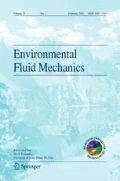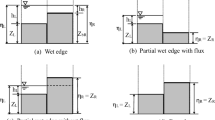Abstract
Research on interactions among wave, current, and vegetation has received increasing attention. An explicit depth-averaged hydrodynamic model coupled with a wave spectral model (CMS-wave) was proposed in this study in order to simulate the wave and wave-induced current in coastal waters. The hydrodynamic model was based on the finite volume method while the intercell flux was computed by employing the Harten–Lax–van Leer approximate Riemann solver to investigate the dry-to-wet interface, and the drag force of vegetation was modeled as the sink terms in the momentum equations. The CMS-wave model was used to investigate the non-breaking and the breaking random waves propagation in vegetation fields. Afterwards, an empirical wave energy dissipation term with plant effect was derived to represent the resistance induced by aquatic vegetation in the wave-action balance equation. The established model was calibrated and validated with both the experimental and field data. The results showed that the wave height decreased significantly along the wave propagation direction in the presence of vegetations. The sensitivity analysis for the plant density, the wave height, and the water depth were performed by comparing the numerical results for the wave height attenuation. In addition, wave and wave-induced current through a finite patch of vegetation in the surf zone were investigated as well. The strong radiation stress gradient could be produced due to the variation of the energy dissipation by vegetation effect in the nearshore zone, which impacted the direction and amplitude of the longshore current. The calculated results showed that the coupling model had good performance in predicting wave propagation and the current over vegetated water regions.















Similar content being viewed by others
References
Anderson ME, Smith JM (2014) Wave attenuation by flexible, idealized salt marsh vegetation. Coast Eng 83:82–92
Das S, Crépin AS (2013) Mangroves can provide protection against wind damage during storms. Estuar Coast Shelf S 134:98–107
Horstman EM, Dohmen-Janssen CM, Narra PMF et al (2014) Wave attenuation in mangroves: a quantitative approach to field observations. Coast Eng 94:47–62
Jadhav R, Chen Q (2012) Field investigation of wave dissipation over salt marsh vegetation during tropical cyclone. Coast Eng Proc 1(33):1–11
Augustin LN, Irish JL, Lynett P (2009) Laboratory and numerical studies of wave damping by emergent and near-emergent wetland vegetation. Coast Eng 56:332–340
Dubi A, Torum A (1997) Wave energy dissipation in kelp vegetation. In: Edge BL (ed) Proceedings of the twenty-fifth coastal engineering conference. American Society of Civil Engineering, New York, 2626–2639
Irtem E, Gedik N, Kabdasli MS, Yasa NE (2009) Coastal forest effects on tsunami run-up heights. Ocean Eng 36(3–4):313–320
Lovas SM (2000) Hydro-physical conditions in kelp forests and the effect on wave damping and dune erosion: a case study on Laminaria hyperborea. PhD thesis, University of Trondheim, The Norwegian Institute of Technology, Trondheim, Norway
Maza M, Lara JL, Losada IJ (2015) Tsunami wave interaction with mangrove forests: a 3-D numerical approach. Coast Eng 98:33–54
Méndez FJ, Losada IJ (2004) An empirical model to estimate the propagation of random breaking and nonbreaking waves over vegetation fields. Coast Eng 51:103–118
Moller I, Spencer T, French JR, Leggett DJ, Dixon M (1999) Wave transformation over salt marshes: a field and numerical modelling study from North Norfolk, England. Estuar Coast Shelf S 49:411–426
Turker U, Yagci O, Kabdasl MS (2006) Analysis of coastal damage of a beach profile under the protection of emergent vegetation. Ocean Eng 33:810–828
Zeng C, Li CW (2014) Measurements and modeling of open-channel flows with finite semi-rigid vegetation patches. Environ Fluid Mech 14(1):113–134
Kobayashi N, Raichle AW, Asano T (1993) Wave attenuation by vegetation. J Waterw Port Coast Ocean Eng 119:30–48
Li CW, Yan K (2007) Numerical investigation of wave–current–vegetation interaction. J Hydraul Eng 133(7):794–803
Maza M, Lara JL, Losada IJ (2013) A coupled model of submerged vegetation under oscillatory flow using Navier–Stokes equations. Coast Eng 80(7):16–34
Maza M, Lara JL, Losada IJ, Ondiviela B, Trinogga J, Bouma TJ (2015) Large-scale 3-D experiments of wave and current interaction with real vegetation. Part 2: experimental analysis. Coast Eng 106:73–86
Zhan JM, Yu LH, Li CW et al (2014) A 3-D model for irregular wave propagation over partly vegetated waters. Ocean Eng 75:138–147
Zhang ML, Hao ZN, Zhang YP, Wu WM (2013) Numerical simulation of solitary and random wave propagation through vegetation based on VOF method. Acta Oceanol Sin 32(7):38–46
Ma GF, Kirby JT, Su SF, Figlus J, Shi FY (2013) Numerical study of turbulence and wave damping induced by vegetation canopies. Coast Eng 80:68–78
Tang J, Shen SD, Wang H (2015) Numerical model for coastal wave propagation through mild slope zone in the presence of rigid vegetation. Coast Eng 97:53–59
Chen Q, Zhao HH (2012) Theoretical models for wave energy dissipation caused by vegetation. J Eng Mech 138(2):221–229
Suzuki T, Zijlema M, Burger B, Meijer MC, Narayan S (2012) Wave dissipation by vegetation with layer schematization in SWAN. Coast Eng 59(1):64–71
Buttolph AM, Reed CW, Kraus NC, Ono N et al (2006) Two-dimensional depth-averaged circulation model CMS-M2D: version 3.0, report 2, sediment transport and morphology change. Coastal inlets research program
Ding Y, Wang SSY, Jia YF (2006) Development and validation of a quasi-three-dimensional coastal area morphological model. J Waterw Port Coast Ocean Eng 132(6):462–476
Park KY, Borthwick AGL (2001) Quadtree grid numerical model of nearshore wave–current interaction. Coast Eng 42:219–239
Zhang ML, Wu WM, Lin LH et al (2012) Coupling of wave and current numerical model with unstructured quadtree grid for nearshore coastal waters. Sci China Technol Sci 55(2):568–580
Mase H (2001) Multidirectional random wave transformation model based on energy balance equation. Coast Eng 43(4):317–337
Lin LH, Demirbilek Z, Mase H, Zheng JH (2008) CMS-wave: a nearshore spectral wave processes model for coastal inlets and navigation projects. U. S. Army Engineer Research and Development Center, Coastal and Hydraulics Laboratory, Vicksburg
Zheng JH, Mase H, Demirbilek Z, Lin LH (2008) Implementation and evaluation of alternative wave breaking formulas in a coastal spectral wave model. Ocean Eng 35:1090–1101
Dalrymple RA, Kirby JT, Hwang PA (1984) Wave diffraction due to areas of energy dissipation. J Waterw Port Coast Ocean Eng 110:67–79
Nadaoka K, Yagi H (1998) Shallow-water turbulence modelling and horizontal large-eddy computation of river flow. J Hydraul Eng ASCE 124:493–500
Kuriyama Y, Ozaki Y (1993) Longshore current distribution on a bar-trough beach, field measurements at HORF and numerical model, report of Port and Harbour Research Institute. Ministry of Transport, Japan, pp 3–37
Acknowledgments
This work was supported by the National Nature Science Foundation of China (51579030), the Program for Liaoning Excellent Talents in University (LJQ2013077), the Liaoning Natural Science Foundation (2014020148), and the Open Fund of the State Key Laboratory of Hydraulics and Mountain River Engineering (SKHL1517).
Author information
Authors and Affiliations
Corresponding author
Rights and permissions
About this article
Cite this article
Zhang, M., Qiao, H., Xu, Y. et al. Numerical study of wave–current–vegetation interaction in coastal waters. Environ Fluid Mech 16, 965–981 (2016). https://doi.org/10.1007/s10652-016-9460-5
Received:
Accepted:
Published:
Issue Date:
DOI: https://doi.org/10.1007/s10652-016-9460-5




